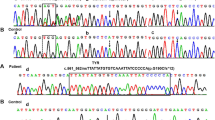Abstract
Purpose
To perform molecular analysis of five Korean patients with oculocutaneous albinism (OCA) and review the clinical and genetic characteristics of 21 Korean OCA patients.
Methods
TYR, OCA2 and SLC45A2 were analyzed by direct DNA sequencing in five unrelated OCA patients who received thorough ophthalmic evaluation.
Results
We identified three different TYR mutations in three patients (c.929dupC, R278X, and R52I), among which the latter two had been previously reported in other populations, but are reported here for the first time in a Korean context. In one patient we identified two different mutations of OCA2 [c.1784+1G>A and c.1842G>T (K614N)]. One patient was confirmed to have OCA4 by detecting two SLC45A2 mutations [c.469G>A (D157N) and c.686G>A (C229Y)]. OCA1A (66.7%) was the most common subtype in 21 Korean albinism patients, and 70% of patients were heterozygotes for 2 different mutational alleles. c.929dupC (54.8%) and R77Q (16.1%) were the most frequent mutational alleles of TYR in Koreans.
Conclusions
Three mutational alleles, R278X and R52I of the TYR gene and C229Y of the SLC45A2 gene, are added to the mutational spectra of Korean patients with OCA, and we report the first Korean case of OCA2 with the OCA2 gene mutations.



Similar content being viewed by others
References
Summers CG. Albinism: classification, clinical characteristics, and recent findings. Optom Vis Sci. 2009;86:659–62.
Kim WJ, Kim SH, Jung DS, Ko HC, Kim MB, Kwon KS. A case of oculocutaneous albinism induced by tyrosinase mutation. Korean J Dermatol. 2009;47:1291–5.
Inagaki K, Suzuki T, Shimizu H, Ishii N, Umezawa Y, Tada J, et al. Oculocutaneous albinism type 4 is one of the most common types of albinism in Japan. Am J Hum Genet. 2004;74:466–71.
Newton JM, Cohen-Barak O, Hagiwara N, Gardner JM, Davisson MT, King RA, et al. Mutations in the human orthologue of the mouse underwhite gene (uw) underlie a new form of oculocutaneous albinism, OCA4. Am J Hum Genet. 2001;69:981–8.
Wei A, Wang Y, Long Y, Wang Y, Guo X, Zhou Z, et al. A comprehensive analysis reveals mutational spectra and common alleles in Chinese patients with oculocutaneous albinism. J Invest Dermatol. 2010;130:716–24.
Suzuki T, Tomita Y. Recent advances in genetic analyses of oculocutaneous albinism types 2 and 4. J Dermatol Sci. 2008;51:1–9.
Tripathi RK, Strunk KM, Giebel LB, Weleber RG, Spritz RA. Tyrosinase gene mutations in type I (tyrosinase-deficient) oculocutaneous albinism define two clusters of missense substitutions. Am J Med Genet. 1992;43:865–71.
Gershoni-Baruch R, Rosenmann A, Droetto S, Holmes S, Tripathi RK, Spritz RA. Mutations of the tyrosinase gene in patients with oculocutaneous albinism from various ethnic groups in Israel. Am J Hum Genet. 1994;54:586–94.
Park SK, Lee KH, Park KC, Lee JS, Spritz RA, Lee ST. Prevalent and novel mutations of the tyrosinase gene in Korean patients with tyrosinase-deficient oculocutaneous albinism. Mol Cells. 1997;7:187–91.
Park KC, Park SK, Lee YS, Youn SW, Park BS, Kim KH, et al. Mutations of the tyrosinase gene in three Korean patients with type I oculocutaneous albinism. Jpn J Hum Genet. 1996;41:299–305.
Hwang JH, Youn SW, Ahn JS, Kim KH, Park KC. Molecular analysis of oculucutaneous albinism patients in Korea. Ann Dermatol. 1997;9:182–7.
Suzuki T, Inagaki K, Fukai K, Obana A, Lee ST, Tomita Y. A Korean case of oculocutaneous albinism type IV caused by a D157N mutation in the MATP gene. Br J Dermatol. 2005;152:174–5.
Sundaresan P, Sil AK, Philip AR, Randolph MA, Natchiar G, Namperumalsamy P. Genetic analysis of oculocutaneous albinism type 1 (OCA1) in Indian families: two novel frameshift mutations in the TYR gene. Mol Vis. 2004;27:1005–10.
Chaki M, Mukhopadhyay A, Ray K. Determinations of variants in the 3’-region of the tyrosinase gene requires locus specific amplification. Hum Mutat. 2005;26:5–8.
Inagaki K, Suzuki T, Shimizu H, Ishii N, Umezawa Y, Tada J, et al. Oculocutaneous albinism type 4 is one of the most common types of albinism in Japan. Am J Hum Genet. 2004;74:466–71.
Lee ST, Nicholls RD, Jong MT, Fukai K, Spritz RA. Organization and sequence of the human P gene and identification of a new family of transport proteins. Genomics. 1995;26:354–63.
Spritz RA, Fukai K, Holmes SA, Luande J. Frequent intragenic deletion of the P gene in Tanzanian patients with type II oculocutaneous albinism (OCA2). Am J Hum Genet. 1995;56:1320–3.
Tomita Y, Miyamura Y, Kono M, Nakamura R, Matsunaga J. Molecular bases of congenital hypopigmentary disorders in humans and oculocutaneous albinism 1 in Japan. Pigment Cell Res. 2000;13:130–4.
Goto M, Sato-Matsumura KC, Sawamura D, Yokota K, Nakamura H, Shimizu H. Tyrosinase gene analysis in Japanese patients with oculocutaneous albinism. J Dermatol Sci. 2004;35:215–20.
Oetting WS, Fryer JP, King RA. Mutations of the human tyrosinase gene associated with tyrosinase related oculocutaneous albinism (OCA1). Hum Mutat. 1998;12:433–4.
Wattanasirichaigoon D, Suwannarat P, Thongpradit S. Two novel splice mutations of P gene in a Thai-Chinese patient with oculocutaneous albinism type II (OCA2). J Dermatol Sci. 2008;49:98–101.
Suzuki T, Miyamura Y, Matsunaga J, Shimizu H, Kawachi Y, Ohyama N, et al. Six novel P gene mutations and oculocutaneous albinism type 2 frequency in Japanese albino patients. J Invest Dermatol. 2003;120:781–3.
Suzuki T, Inagaki K, Fukai K, Obana A, Lee S-T, Tomita Y. A Korean case of oculocutaneous albinism type IV caused by a D157N mutation in the MATP gene. Br J Dermatol. 2005;152:174–5.
Inagaki K, Suzuki T, Ito S, Suzuki N, Adachi K, Okuyama T, et al. Oculocutaneous albinism type 4: six novel mutations in the membrane-associated transporter protein gene and their phenotypes. Pigment Cell Res. 2006;19:451–3.
Acknowledgments
This work was supported by the Korea Research Foundation Grant funded by the Korean Government (KRF-313-2008-2-E00521).
Author information
Authors and Affiliations
Corresponding author
About this article
Cite this article
Park, S.H., Chae, H., Kim, Y. et al. Molecular analysis of Korean patients with oculocutaneous albinism. Jpn J Ophthalmol 56, 98–103 (2012). https://doi.org/10.1007/s10384-011-0098-z
Received:
Accepted:
Published:
Issue Date:
DOI: https://doi.org/10.1007/s10384-011-0098-z




